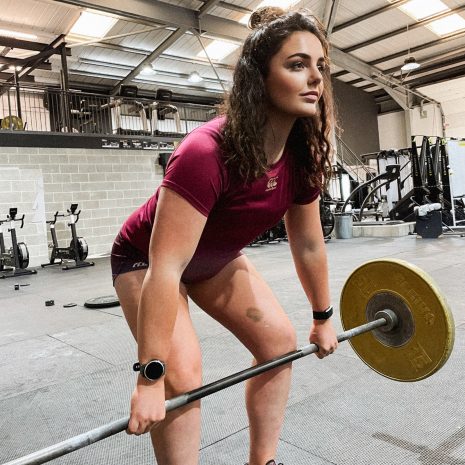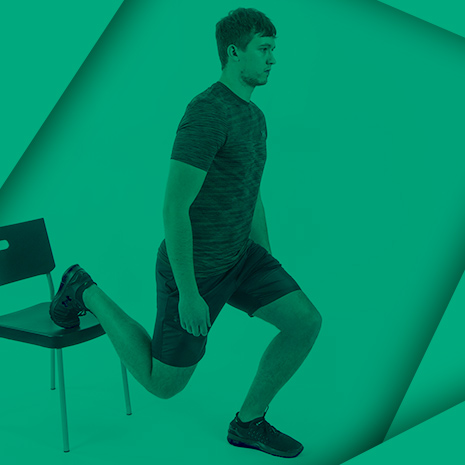The team at rugbystore has teamed up with esteemed Chartered Physiotherapist, Neil Aitken to give you high-quality information on the most common Rugby injuries and how to best recover from them. If there’s a particular injury you’d like us to cover with Neil’s help, get in touch with us on social media (Facebook | Twitter).
Causes Of Hamstring Injury
The hamstrings have a very complex role during the action of running and are therefore prone to injury. They must first work concentrically (shorten) to flex the knee and lift the foot off the ground when it is behind you. At the end of the swing phase, the hamstrings must work eccentrically (as they lengthen) to apply a braking moment to knee extension, then immediately change functions to again concentrically contract and produce hip extension, propelling you forwards when your foot is planted.


Studies have shown that the hamstring group reaches peak elongation, is most active and develops the greatest torques at the hip and knee during the late swing through the mid-stance phase of running. Thus, the hamstrings reach their maximum length while attempting to forcefully work eccentrically and switch functions to immediately produce a concentric contraction, which makes the terminal part of swing phase the most vulnerable for injury.
If the muscle is weak or fatigued it may not cope with this force and this is when injuries can happen. Interestingly, as we often see in physio, a previous hamstring injury is the most common predictor of having a new hamstring injury. Studies show that 34% of hamstring injuries are recurrences of a previous injury. The obvious question is why? Hamstring strength is the key factor in the prevention of injury. It seems that people are pain-free before they have returned to 100% strength and therefore return to play while they are still at a risk of recurrence.
Studies show that 34% of hamstring injuries are recurrences of a previous injury.
Degrees Of Hamstring Injury

Grade 1
This is a mild strain of some of the muscle fibres. You may feel a sensation of tightness and a low level of pain when the hamstring muscles are stretched or contracted.
Grade 2
More muscle fibres are strained and the feeling of pain is higher. There may also be signs of swelling with bruising tracking out of the muscle after a few days. This will then move down the leg due to gravity.
Grade 3
A grade three hamstring strain is a more severe injury. There is an immediate burning or stabbing pain and the individual is unable to walk without pain. The injured section of the muscle has ruptured and there may be a large lump of muscle tissue above a depression where the tear is. This should be assessed by a physio/GP, as although conservative management may be possible, there may also be the need for surgery.
Hamstring Injury Recovery
As always, if you are concerned about the severity of your injury, you should be assessed by a qualified person such as a physiotherapist or doctor. The following is a guide only. Each case is different and the management will therefore differ depending on various factors including (but not limited to) the individual and the severity of the injury.
Early Days:

As with most injuries, the first 5-7 days is the time to limit damage and let the area settle. During this time, the PRICE regime should be followed. Protection, Rest, Ice, Compression and Elevation. Ice can be applied for 20 minutes every 2 hours. Protection and rest may involve the use of crutches to limit the use of the hamstrings.
Rehabilitation:
When to start your rehab will depend on the grade of the muscle strain. You could start rehab at 5 days if the pain has settled or it may be a few weeks in more severe cases.
Strengthening is the most important factor. The muscle should also return to its normal length through stretching, rehab and general use. Strength training should incorporate gentle recruitment in the early stages through to peak power output both eccentrically and concentrically at end stage rehab. Endurance/fatigue should also be considered in your rehab.
As a basic guide, the following exercises could be used as a progression:
1. Standing hamstring curls against gravity: Simply bend your knee to bring your foot towards your bottom. Keep your knees side by side during this motion.
2. Hamstring Bridge: Lie on your back with your knees bent. You can target the hamstrings by having your feet as far from your bottom as possible. Perform the exercise by lifting your bottom off the ground. Hold for 10 seconds and repeat x10. Progress this to the injured side only, i.e. keep your good leg off the floor so only the injured side is working to lift your bottom off the floor.
3. Hamstring curls: Perform a seated or prone hamstring curl with a resistance band or the traditional machines in the gym.
4. Deadlift: Perform both a traditional deadlift and its single leg variation.
5. Nordic Curls: This is a very good exercise once the injury has reached the point it can tolerate it. This exercise should be used on an ongoing basis to maintain hamstring strength. Check out this video guide on how to perform a Nordic Curl.
6. Kettlebell swings: If done correctly these replicate the switch from eccentric control to concentric action required by the hamstrings in running (check out rugbystore’s range of kettle bells)
7. Plyometric training should then be used to make sure that the hamstring can cope with peak torque and fatigue.
8. Return to running/sprinting/cutting drills should be used prior to return to rugby training.
About the author
Neil Aitken is a Chartered Physiotherapist with a private clinic in Edinburgh. He has previous experience as a senior physiotherapist in the NHS and provided physio for one of the top amateur rugby teams in Scotland. He is highly evidence-based having completed a Post Grad in Musculoskeletal Physiotherapy gaining membership to the MACP, one of the most highly respected qualifications within physiotherapy.
Website: http://www.neilaitkenphysio.co.uk/
Facebook: https://www.facebook.com/neilaitkenphysio/
Twitter: @aitkenphysio

Please note, this article is intended to serve as a guide for general information only. Injuries should be assessed by a qualified specialist such as a physiotherapist or doctor. When you sustain an injury, there are always complicating factors that may need to be assessed and addressed by a professional.




Comments